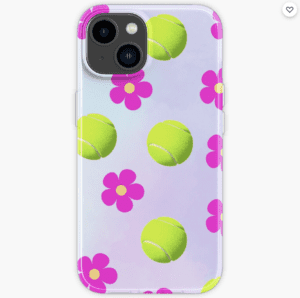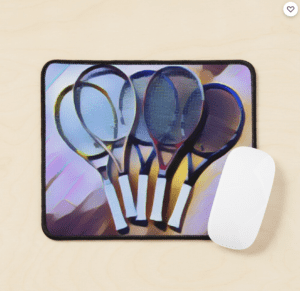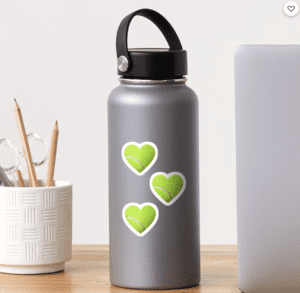Hybrid Tennis Lessons: Exploring the Possibilities of Teaching and Learning From Anywhere
 The hybrid learning and teaching approach has now been adopted by many industries. But can hybrid tennis lessons work within our industry? Although video conferencing is here to stay, many people feel fatigued from learning or working exclusively via Zoom for the past year. Surely, we can all agree that tennis lessons on the court are most beneficial. Additionally, tennis was always considered one of the safest in-person activities during the pandemic, making it an ideal sport for those anxious about getting sick from Covid or other viruses.
The hybrid learning and teaching approach has now been adopted by many industries. But can hybrid tennis lessons work within our industry? Although video conferencing is here to stay, many people feel fatigued from learning or working exclusively via Zoom for the past year. Surely, we can all agree that tennis lessons on the court are most beneficial. Additionally, tennis was always considered one of the safest in-person activities during the pandemic, making it an ideal sport for those anxious about getting sick from Covid or other viruses.
So, you may wonder, why bother doing hybrid lessons?
There are many reasons why you should consider teaching part of your lessons online. In this blog post, we will explore whether hybrid tennis lessons are right for you, and how such a model of teaching can supplement your teaching income, offer a new dimension of learning for your students, and unlock some new career opportunities.
Why hybrid learning has become so popular
Hybrid learning, also known as blended learning, has become increasingly popular in many industries, including sports such as tennis. This approach combines traditional in-person instruction with online learning resources and tools, creating a more flexible and personalized learning experience.
One of the main drivers of the rise of hybrid learning is the increased availability and accessibility of technology. With video conferencing software, basic equipment, and online tools, it has become easier to connect with coaches and students from anywhere in the world and access high-quality learning resources and training materials.
In the education industry, hybrid learning has been a popular model for colleges and universities for decades. This approach allows students to access course materials and lectures online while still receiving in-person instruction and support from teachers and professors. It also provides students with greater flexibility in terms of when and where they study, which can be especially important for those who work or have other commitments.
Hybrid learning has also been used to provide employees with ongoing professional development and upskilling. This approach allows employees to access training materials and resources online while still receiving in-person coaching and feedback from trainers.
Can hybrid tennis lessons work for tennis?
Online learning has been present in the sports industry for quite some time. Many tennis coaches offer lessons on video channels like YouTube or their website. However, one issue with these platforms is that the content is often too general to be useful for everyone. Personalizing tennis lessons can be challenging when trying to appeal to a broader audience.
Hybrid learning, on the other hand, can be personalized and easily implemented in individual sports like tennis. Players can benefit from coaching and feedback by combining in-person coaching sessions with live online video lessons.
Think about the times when lessons had to be canceled due to bad weather, lack of court time, or someone being sick. Or the periods when it's challenging to fill the "dead" hours in the middle of the day when everyone is either working or in school. Or those days when you are exhausted after an eight-hour teaching day.
What if you could spend two to three of those "dead" teaching hours setting up your home with technology and space to teach tennis lessons online, improving your schedule and providing your students with an excellent learning opportunity?
What exactly are hybrid tennis lessons?
Before we delve into the 'How', let's clarify what hybrid tennis lessons are. Hybrid tennis lessons, also known as blended tennis lessons, combine traditional in-person coaching sessions with online coaching and learning tools. In other words, this approach allows for part-time online access to coaching and instruction from experienced coaches while also incorporating lessons in-person, on the tennis court. The online sessions can be done from anywhere, and the location of the student or teacher does not normally matter.
The online video lessons portion can involve watching a recording of the student and analyzing it to provide feedback on technique and strategy. It can also be a tennis pro showing specific footwork or exercises with specialized tennis equipment that can be done by the student at home. The online portion can be done live, pre-recorded, or include a partial recording. All that is needed is a video conferencing software with the ability to record and a camera with a decent quality lens (phone cameras are great nowadays).
When the online portion of the hybrid setup is done live, students can interact with their coaches in real-time, receive personalized feedback, and improve their skills in a flexible and convenient way. These remote teaching sessions can be done during lunch breaks, before going to work, or on weekends, making it flexible and convenient for students.
Comparison of hybrid tennis lessons to traditional in-person lessons and online video lessons
When it comes to tennis coaching, there are several different ways to do it: 1) traditional in-person lessons, 2) online video lessons, and 3) hybrid tennis lessons. Here's how they compare:
- Traditional in-person lessons:
These lessons involve meeting with a coach in person, typically at a tennis court or another training facility. It used to be the only way to learn tennis until recently. Traditional lessons offer a personalized coaching experience where the coach can observe and correct the student's technique in real-time, move the student's racket, feed tennis balls, change the location as needed, play practice points, and more. However, they can be expensive and time-consuming, and students typically have to travel to attend lessons.
- Online video lessons:
These lessons involve watching instructional videos and tutorials online. They offer a more flexible and cost-effective option compared to traditional in-person lessons, but while such videos are a good reference and provoke thought and analysis, they lack the personalized feedback and coaching that comes with traditional, in-person lessons.
- Hybrid tennis lessons: As previously mentioned, hybrid tennis lessons combine the benefits of both traditional in-person lessons and online video lessons. Students can receive personalized feedback from a coach in real-time, as well as have access to online video lessons and other resources to supplement their learning. They offer flexibility and convenience by practicing things that can be done away from the court, online, while the student and coach still get to interact and practice shots on the tennis court for the rest of the time.
Overall, each type of coaching has its own strengths and weaknesses, and it is up to the individual student and teacher to decide which option works best for them. However, hybrid tennis lessons offer a unique combination of the advantages of these three approaches. As a coach, it also gives you a chance to earn some extra income or, in some cases, teach online while recovering from an injury or if you wish to “lighten up” your in-person teaching.
What technology is needed to run hybrid tennis lessons?
Please note the information below may contain affiliate links, which means I’ll receive a commission if you purchase through my link, at no extra cost to you. Please read full disclosure here.
Hybrid tennis lessons rely on several technologies to enable students and coaches to teach and learn from anywhere in the world. The primary technology used is video conferencing software such as Zoom, Skype, or Facetime, which allows students and coaches to communicate in real-time and interact as if they were in the same room.
This software also allows for screen sharing, enabling coaches to present instructional materials and videos, draw over court diagrams, and annotate students' movements for feedback. It can also record sessions that can be reviewed later on.
Specialized tennis equipment such as tennis sensors, ball machines, gadgets, at-home training tools, and hitting targets can also be used in hybrid tennis lessons. Tennis sensors can be attached to the racket or the body to monitor and analyze the player's movements and provide data on their strokes, speed, and spin. Watches can keep track of fitness data.
On the equipment side, ball machines can be used by the student (or with the help of a student’s parent) to practice alone and record the session. The ball machine practice can be set up to simulate different types of match situations or practice specific techniques. Hitting targets can be placed on the court to help players improve their accuracy and consistency. Recording the practice can be easily done with a phone camera and a small tripod, which can be analyzed by the coach during the online sessions.
If court time is not available, there are many fun tools that can be used to train at home. A few examples of popular training aids include jump ropes, weights, ServeMaster and TossMaster, The EyeCoach Pro and Jr., and TopSpinPro.
In addition to video conferencing and specialized equipment, a stable internet connection, high-quality cameras, and microphones are necessary to ensure clear, quality communication and reduce technical issues. Most phones and laptops have such cameras and microphones, but it is always worth giving your equipment a test run before scheduling the online portion of your hybrid lessons.
With the right setup and technology, hybrid tennis lessons can provide an effective and positive training experience for both players and coaches.
Download eBook
Tennis Club Marketing 101
Marketing Ideas for Tennis Club Owners, Managers, and Coaches.
The process for setting up and participating in a hybrid tennis lesson
Setting up and participating in a hybrid tennis lesson requires a few key steps. Tennis coaches must start by notifying their students of the availability of such a learning model. The coach and student must agree on a schedule, which portions of the tennis lessons will be held online, and, of course, the cancellation policy. Such lesson “packages” can be announced on coaches’ websites, social media, or by contacting clients directly via phone or email. They can be purchased on the coaches’ website, or sign up can be done by using a physical paper form.
Once you have scheduled the lessons, you will need to ensure that your technology and equipment work well. Testing your computer, mobile devices, camera, and microphone with a stable internet connection is a must-do a few days prior to the first lesson. If you plan to use specialized tennis equipment, such as sensors or ball machines, make sure you have them available within reach and set up.
Before the lesson, the coach and student should communicate and discuss the online lesson’s goals, skills, and any areas of focus. Make sure you complete any necessary paperwork, waivers, or payment arrangements.
To start the online lesson, you will typically connect with your student through a video conferencing platform such as Zoom or Skype. Be a few minutes early on the video call! The coach can provide tennis stroke instruction, give feedback, do analysis, discuss the mental game of tennis, and support while the students practice their tennis skills. You may also choose to use specialized equipment to show and supplement the training.
In the last five minutes of the online tennis instruction, you may also schedule or discuss the next lessons.
Overall, the process for setting up and participating in a hybrid tennis lesson is pretty straightforward. With the right technology and equipment, hybrid tennis lessons can provide a flexible, convenient, and effective way to improve anyone’s tennis skills. After all, there is so much to learn!
Camera-shy? Not feeling “techy” enough?
Here is a list of reasons why some coaches might initially say "no" to hybrid tennis lessons:
Some people are intimidated by technology and cameras, find technology difficult to use, and tend to panic when something does not work properly.
Since online lessons do not offer the same level of in-person interaction and connection that traditional in-person lessons provide, it may be harder for students to establish a strong relationship with their coach, which could potentially impact the quality of the coaching experience.
The good news is that "practice makes perfect" and it's important to give online instruction a few tries before deciding whether it is for you or not. Here are a few tips to help you get camera-ready:
- Be prepared: Write an outline or agenda for the online lesson you would like to teach.
- Get help: If you do not feel confident with technology, ask a friend to help you test things out.
- Test, test, 1, 2, 3: Try to test every piece of equipment before going live.
- Practice: Run the lesson in your head, take notes, speak to the computer camera, and record yourself. Watch and repeat.
In the worst-case scenario, have a detailed agenda with notes on how long each lesson point should take.
While there are some challenges associated with hybrid tennis lessons, with proper preparation and planning, they can be a "win-win" for both the student and the coach.
Last few tips for making the most of hybrid tennis lessons
- We cannot emphasize this enough, and let's repeat it in all caps: MAKE SURE YOU HAVE A RELIABLE HIGH-SPEED INTERNET CONNECTION to support video conferencing and streaming. Check with your internet provider if you're unsure about what you have. You do not want to watch a frozen or blurry screen for half of the session.
- Select a location with ample space that allows you to move around, swing a racket, and practice without obstruction.
- Consider lighting, background noise, and distractions, as these can all impact the quality of the session.
- Have all your specialized tennis equipment, such as a tennis racket, balls, gadgets, and markers, within reach. You do not want to spend five minutes of your student's time searching for a tennis ball. You may also require additional equipment like a tripod or small table to position your camera or laptop for the best angle.
- Ensure that you have installed and tested the necessary software (e.g., Zoom) and applications before the session to avoid any delays or technical issues.
Maximizing engagement and interaction during virtual lessons
To keep their students motivated and focused, coaches can use several techniques to encourage interaction during virtual tennis lessons:
- Use video analysis tools to record and review the student's progress. This can help provide feedback and instruction on their technique.
- Incorporate Q&A sessions throughout the lessons to encourage student participation.
- Allow students to self-evaluate and refine their analytical skills.
- Use quizzes and drills to stimulate participation and encourage active learning.
- Incorporate games and challenges that mimic the feel of a real match to keep the student engaged and motivated.
By utilizing these strategies, coaches can create an interactive and engaging environment for their virtual lessons and make them fun for their students, while ensuring that learning takes place.
Importance of maintaining open communication with your coach
Whether you are new to online instruction or experienced virtual coach, you may want to ask for some constructive feedback (e.g., parts they liked, parts that were unclear). This way, you can identify the areas you can improve on and gain a better understanding of their needs and preferences, and tailor your coaching to their online learning style.
Encouraging your student to ask questions and provide feedback also fosters a sense of ownership and commitment, helping them become more invested in the learning process.
Hybrid tennis lessons are an innovative approach to coaching that combines the flexibility of online learning with the benefits of in-person coaching. With the right setup and approach, hybrid lessons can be an effective way to improve your students’ tennis skills and reach additional career goals.
As the world continues to adapt to the changing landscape of training, learning, and coaching, hybrid options have emerged as a viable and effective alternative to traditional in-person lessons. Consider incorporating hybrid options into your training regimen. While there may be challenges to overcome when transitioning to a hybrid approach, the benefits are clear.
Ready to try this new approach? Contact Resourcely® for a consulting session, and we will be happy to go through the checklist and help you run those online sessions smoothly.









